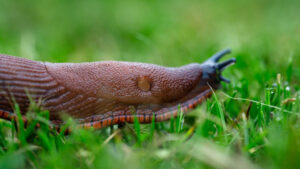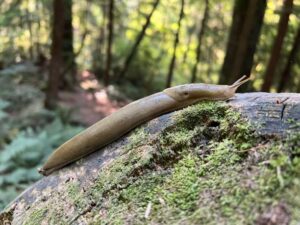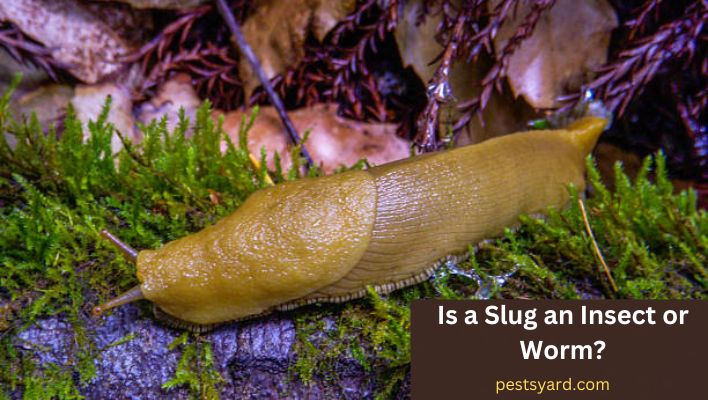A slug is an organism that slugs are a type of shellfish. They can move about and eat other things. You aren’t alone if you’re confused about what a slug is. Many people don’t understand the difference between a slug and an insect. This can lead to many questions, such as is a slug an insect, a worm, or a bug.
The slug is a creature like a tiny snail. Most of us think they are worms, and I’m sure some think they are insects, but the truth is both are wrong. A slug is a soft-bodied animal, so it does not fit into the definition of an insect.
Slugs are mollusk with no shell; they look like tiny snails and are flat, segmented mollusks. They use the tentacles on the end of their bodies to move around and find food. This also helps them find cracks in your sidewalk or basement floor where they can hide until dark. Below is everything you need to know about slugs.
About slugs
It is also called a terrestrial gastropod living in areas where it can find food and shelter from predators. Slugs are a type of invertebrate that are related to snails and limpets. They are also known as land slugs or terrestrial gastropods.
Slugs live in moist places as well as on the ground. They can be brown, black, yellow, or even white. They have long, slender bodies with large-to-small heads, depending on the species. Their mouthparts consist of a pair of horny plates that can be used for capturing prey or defense against predators.
Slugs are unwelcome visitors in many garden. Most slugs are seen as pests because they feed mostly on plants, although there are omnivores by nature. Some species can live in water, where they eat algae or detritus from the bottom of the sea or riverbeds.
Slugs are animals described as “inoffensive” and “harmless” to humans. Slugs can be found in just about every garden, field, and forest you can think of. As such, it is easy to see why many people would not think twice about them.
They are a major part of our ecosystem, and they help control pests in some cases. So, are slugs insects or bugs? It may be hard to identify what is a slug, but one thing is for sure: you’ll want to learn more about this mollusk.
A slug is not an insect.
The slug is not an insect. The slug is a member of the phylum Mollusca, which includes snails and slugs. The Slugs are a group of invertebrates that resemble worms and have several kinds of shells on their bodies.
Slugs, like all mollusks, have a mantle around their head body that acts as a protective shell. The term “insect” refers to the arthropods most closely related to insects, including other arachnids such as spiders and scorpions.
Slugs belong to the class Gastropoda, which includes snails, slugs, and their close relatives. A slug is a mollusk with a tube like shaped body.

side view close-up of a single Spanish slug (Arion Vulgaris, aka Arion lusitanicus)Insects are a diverse group of arthropods that have a chitinous exoskeleton, with antennae. Insects range in size from microscopic to gigantic. The largest known insects are the praying mantis, which can grow up to 9 inches (23 cm) long.
Slugs are mostly omnivore eaters, though some feed on plants with their mouths, and others eat algae found in ponds or streams near where they live and other small animals like insects or even other slugs. They can damage plants by eating plant leaves, stems, and roots.
They are usually found on land surfaces where they may feed on garden vegetation and other plants. Slugs have some appearance with insects. They both have antennae (slugs tentacles) for sensing their surroundings, a mouth for feeding, and a sensory organ.
Slugs are not worms
Even though it’s tempting to assume that because they have long, slender bodies and no legs, slugs must be worms, they’re not. Slugs can sometimes look like worms, but they’re members of the mollusk family and are related to snails and mussels.
The slimy trail they leave behind is called slime, and it comes out when they try to move around on moist surfaces like leaves or soil. These animals also have an internal shell (called the mantle) covering their head.
A slug is a small snail known as a land slug, terrestrial gastropod, or slug. Slugs are usually herbivorous and feed on plants; some are known to feed on dead animals and worms. They can be found worldwide in damp areas like forests and gardens.
Worms are also invertebrates with segmented bodies and a central nervous system. They live in soil and other organic matter like decaying plants and fungi. They’re usually longer than slugs but also have some short varieties; they look like long tubes with many segments.
Worms move by wriggling their bodies like snakes do: they contract and expand their muscles to make it easier to roll over obstacles or crawl through narrow spaces.
Also, worms and slugs both have Eliphas of wiggling bodies (the slug is a tube-like animal); worms are segmented, while slugs are smooth. However, slugs can destroy your garden, while worms benefit the garden.
Difference between a slug and a worm
Slug and worm are terms that refer to two very different animals. While they both have a segmented body, they’re technically not the same.
- The main difference between the two is that slugs are soft-bodied and generally live in moist environments, while worms live on land and in water. They have a head, a body, and an appendage on the front end.
- However, a slug’s body is segmented into two parts: the head and the tail. A worm’s body is composed of several segments; its head does not fit in the middle of its body as in slugs.
- Slugs are mollusks, while worms are segmented animals. Both slugs and worms also have segmented bodies, but the segments of a slug can be arranged in various ways, while those of worms are always the same.
- Slugs also have shells or other protection on their backs, while worms do not.
- Slugs’ heads are typically round, but some have thin lips covering their mouths when feeding. Worms do not have lips and, therefore, cannot eat through them. Instead, they use their mouths for defense; they can suck up to two times their body weight in water when threatened by predators or prey.
- Slugs feed on plants and other animals, while worms feed on decaying matter.
Slugs are not Bugs
Slugs are neither bugs nor insects. They are mollusks, invertebrates with soft bodies and a single opening for excretion. The term “slug” also refers to snail-like creatures, including snails and slugs.
A bug is a small, winged insect part of the order Hemiptera. They mostly have four pairs of legs and usually range from 3 to 5 millimeters in length. Bugs make up a large portion of the insect population, as they are mostly harmless to humans.
Bugs have small eyes and antennae, a pair of wings with a delicate membrane that allows them to fly. They can be found in many different parts of the world, but most often, they are found in tropical climates.
These bugs are known for their adaptability and hardiness. They can easily adapt to various environments, from desert sands to humid forests. Bugs can be found on the ground or in trees when they are not in flight.
They eat plants and other insects; some species will even feed on dead, small animals like lizards or frogs. They do this by sucking up liquid with their mouthparts called mandibles (which look like teeth).
Whereas slugs belong to mollusks, animals of the phylum Mollusca. Mollusks include clams, oysters, octopuses, squids, and mussels. They are related to land snails like Helix aspersa but lack a shell or shell-like covering and have tentacles like snails and other gastropods do.
They are terrestrial animals that live on land surfaces where they can find water or food sources such as plants or animal matter. However, slugs are different from snails in appearance.
Slugs are termed pests because they damage crops by eating the leaves or stems of most plants. Depending on the species, adults can be 3 to 7 inches long. They feed on rotting vegetation or fresh plants, causing them to die by destroying their leaves.
They may also cause damage to lawns or gardens by burrowing into the soil where it’s hard for us humans to reach them without using chemicals.
Slugs are land terrestrial mollusks, while bugs are insects. Both can be a nuisance to your garden, but they’re not the same.

What is a slug’s scientific name?
A slug is a type of gastropod. Gastropods are mollusks, a kind of animal with an invertebrate body plan. Mollusks have soft bodies, and they include slugs and snails. Slugs have no shells, so they can be thought of as having no hard parts.
They are classified under the phylum Mollusca and belong to the class Gastropoda and subclass Heterobranchia.
There are about 7,000 species of slugs in the world, and they are found almost everywhere. Slugs are related to snails but have no shell or a protective covering. They also tend to be much smaller than snails.
They have two pairs of antennas (tentacles) on their heads: one on the lower part and one on the upper part of their heads. Slugs are available in various colors, but brown is the most common color; some species are yellow, black, or greenish-black.
Slugs are hermaphroditic and have both male and female reproductive organs, some times they can mate as well. They are usually nocturnal and burrow into moist soil or plant debris during the day to feed on decaying organic matter and algae that support their metabolism.
They may also seek shelter under objects such as rocks, boards, or bark, where they remain inactive during daylight hours. Most species of slugs are considered to be pests because they damage plants by feeding on the roots or stems of plants.
Are slugs poisonous
Slugs are pretty cool critters, and you can eat them. They live in dirt and muck, so they’re often found near water, but they are not poisonous but can be annoying and carry dangerous diseases.
While some slugs (like the infamous garden slug) can be eaten, most slugs are considered pests because they damage plants and crops by eating leaves or fruit; others may carry disease-causing bacteria and parasites.
They can do a lot of damage if they’re not controlled. These slugs eat the roots of plants and trees, so it’s important to keep an eye on your garden and ensure you’re doing all you can to keep them away.
They’re called “slugs” because they move slowly, so if you don’t notice them immediately, they can sneak up on you when you least expect it.
Slugs are scavengers and will eat any organic matter in their ways. That includes leaves, grasses, and even dead animals. If you see a slug in your garden or lawn, don’t worry, they’re there for a reason.
Do slugs bite?
Slugs are carnivores and eat only small invertebrates, such as snails, worms, and insects. They do not bite humans, but they do have a poison that can be dangerous to humans if ingested uncooked.
Slugs are usually nocturnal and come out after it gets dark or rains. They eat algae and other plant matter, which is why they’re often found near the base of plants.
They have tiny mouths, so they need to feed on a steady diet of algae and other plant life. Slugs will eat whatever they find, from leaves to flowers to stems and even ants. Their bodies are full of digestive juices that help them break down the food they eat into usable nutrients.
Slugs also secrete mucus from their bodies that help keep their skin moist and protect them from being squished by other animals or plants. Slugs also have retractable claws (called “pseudopods”) that help them hold onto their food.
So there you have it: no slugs bite because they don’t have teeth! But don’t let this stop you from trying to scare them away; slugs are pretty easy to tick off if you’re willing to make some noise.
The mouth structure of slugs makes it impossible to bite.
The mouth structure of slugs makes it impossible to bite them because they don’t have teeth or jaws like vertebrates. Instead, slugs use a muscular epipharynx (the pharyngeal section of the mouth) to grip onto things while they suck in moisture through their spiracles.
When they want to chew something, they open their mouths with this part pointing forward and pull their head backward until there’s enough room for them to bite down on whatever they’re trying to grab hold of.
The slug’s mouth comprises four parts: the foot, the radula, the pharynx, and the esophagus.
The foot consists of two parts: a toothed pad that works like an artificial tongue and a pair of teeth aligned with it on each side of the body. These teeth are used to grasp food particles and move them into the mouth.
The radula is a tongue-like organ that moves across surfaces in search of food. It has rows of tiny teeth that grab or scrape up food particles as it moves along surfaces.
The maxillary radula (or radula) is located at the front of the mouth. It consists of two rows of tiny teeth, one on each side. These teeth are arranged in a saw-like pattern called a rasp. The mandibular radula (or radulae) is located behind the maxillary radula and comprises two rows of teeth. These rows are arranged in a comb-like pattern called a comb rasp.
The buccal cavity is located between the mandible and the maxilla. It contains many glands that produce mucus and digestive juices that help break down food particles into smaller pieces so they can be digested easier.
The pharynx connects these two parts, allowing for movement between them and for liquid food to pass through from one region to another. The esophagus ends at the back of the throat, connecting with other internal organs such as digestive glands and respiratory organs.
